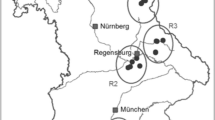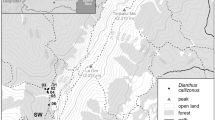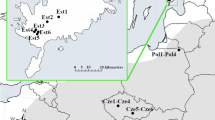Abstract
The aim of this study was to estimate genetic diversity and assess its importance for plant fitness in a species belonging to the most endangered species in Europe, Dracocephalum austriacum L., and to select the most valuable populations for conservation of genetic diversity within the species in the studied regions. We analyzed allozyme variation of 12 populations in three distinct regions (Czech Karst, Moravia and Slovak Karst) in Central Europe. The results showed high genetic diversity within populations (80.14%) and relatively low differentiation among populations within regions (9.42%) and between regions (10.45%). Seed production was significantly higher in larger, genetically more diverse and less inbred populations. The results suggest that genetic diversity has important effect on seed production in this species and thus can be expected to have strong direct consequences for plant fitness and vitality of the whole populations. They also show large variation in genetic diversity between populations and indicate which populations should get a priority in attempts to conserve all the genetic diversity within the region.




Similar content being viewed by others
References
Anderson S, Waldmann P (2002) Inbreeding depression in a rare plant, Scabiosa canescens (Dipsacaceae). Hereditas 136:207–211. doi:10.1034/j.1601-5223.2002.1360305.x
Ayres DR, Ryan FJ (1999) Genetic diversity and structure of the narrow endemic Wyethia reticulata and its congener W. bolanderi (Asteraceae) using RAPD and allozyme techniques. Am J Bot 86:344–353. doi:10.2307/2656756
Ben Fadhel N, Boussaid M (2004) Genetic diversity in wild Tunisian populations of Mentha pulegium L. (Lamiaceae). Genet Resour Crop Evol 51:309–321. doi:10.1023/B:GRES.0000024016.13743.8b
Bonin A, Nicole F, Pompanon F, Miaud C, Taberlet P (2007) Population adaptive index: a new method to help measure intraspecific genetic diversity and prioritize populations for conservation. Conserv Biol 21:697–708. doi:10.1111/j.1523-1739.2007.00685.x
Brzosko E, Wróblewska A, Ratkiewicz M (2002) Spatial genetic structure and clonal diversity of island populations of lady’s slipper (Cypripedium calceolus) from the Biebrza National Park (northeast Poland). Mol Ecol 11:2499–2509. doi:10.1046/j.1365-294X.2002.01630.x
Čeřovský J (1999) Dracocephalum austriacum L. In: Čeřovský J, Feráková V, Holub J, Maglocký Š, Procházka F (eds) Red book of endangered and rare plant and animal species in the Czech and Slovak Republic, vol 5. Príroda, Bratislava, p 138 (in Czech)
Colas B, Olivieri I, Riba M (1997) Centaurea corymbosa, a cliff-dwelling species tottering on the brink of extinction: a demographic and genetic study. Proc Natl Acad Sci USA 94:3471–3476. doi:10.1073/pnas.94.7.3471
Darvill B, Knight M, Goulson D (2004) Use of genetic markers to quantify bumblebee foraging range and nest density. Oikos 107:471–478. doi:10.1111/j.0030-1299.2004.13510.x
DeMauro M (1993) Relationship of breeding system to rarity in the lakeside daisy (Hymenoxys acaulis var. glabra). Conserv Biol 7:542–550. doi:10.1046/j.1523-1739.1993.07030542.x
Dostálek T (2005) Identification of critical life history stages in the life cycle of endangered species, Dracocephalum austriacum L. Ms. Master thesis, depon. Department of Botany, Faculty of Science, Charles University, Prague
Ellstrand N, Elam D (1993) Population genetic consequences of small population size: implications for plant conservation. Annu Rev Ecol Syst 24:217–242. doi:10.1146/annurev.es.24.110193.001245
Excoffier LGL, Schneider S (2005) Arlequin ver. 3.0: an integrated software package for population genetics data analysis. Evol Bioinform Online 1:47–50
Faugeron S, Martínez EA, Correa JA, Cardenas L, Destombe C, Valero M (2004) Reduced genetic diversity and increased population differentiation in peripheral and overharvested populations of Gigartina skottsbergii (Rhodophyta, Gigartinales) in southern Chile. J Phycol 40:454–462
Fischer M, Matthies D (1998) RAPD variation in relation to population size and plant fitness in the rare Gentianella germanica (Gentianaceae). Am J Bot 85:811–819. doi:10.2307/2446416
Fischer M, Husi R, Prati D, Peintinger M, van Kleunen M, Schmidt B (2000) RAPD variation among and within small and large populations of the rare clonal plant Ranunculus reptans (Ranunculaceae). Am J Bot 87:1128–1137. doi:10.2307/2656649
Frankham R (1996) Relationship of genetic variation to population size in wildlife. Conserv Biol 10:1500–1508. doi:10.1046/j.1523-1739.1996.10061500.x
Frankham R, Ralls K (1998) Inbreeding leads to extinction. Nature 392:441–442. doi:10.1038/33022
Gaudeul M, Taberlet P, Till-Bottraud I (2000) Genetic diversity in an endangered alpine plant, Eryngium alpinum L. (Apiaceae), inferred from amplified fragment length polymorphism markers. Mol Ecol 9:1625–1638. doi:10.1046/j.1365-294x.2000.01063.x
Glémin S, Gaude T, Guillemin M, Lourmas M, Olivieri I, Mignot A (2005) Balancing selection in the wild: testing population genetics theory of self-incompatibility in the rare species Brassica insularis. Genetics 171:279–289. doi:10.1534/genetics.104.035915
Godt MJW, Caplow F, Hamrick JL (2005) Allozyme diversity in the federally threatened golden paintbrush, Castilleja levisecta (Scrophulariaceae). Conserv Genet 6:87–99
Hamerský R (2000) Dracocephalum austriacum L. In: NATURA 2000—maping and botanical survey in localities of endangered species of vascular plants (České středohoří Mts.). Ms., depon. in AOPK ČR, Prague (in Czech)
Hamrick JL, Godt MJW (1989) Allozyme diversity in plant species. In: Brown AHD, Clegg MT, Kahler AL, Weir BS (eds) Plant population genetics, breeding and genetic resources. Sinauer, Sunderland, MA, pp 43–63
Hamrick JL, Murawski DA, Loveless MD (1991) Correlations between species traits and allozyme diversity: implications for conservation biology. In: Falk DA, Holsinger KE (eds) Genetics and conservation of rare plants. Oxford University Press, New York, pp 75–86
Hensen I, Oberprieler C (2005) Effects of population size on genetic diversity and seed production in the rare Dictamnus albus (Rutaceae) in central Germany. Conserv Genet 6:63–73. doi:10.1007/s10592-004-7745-6
Heufler L (1851) Trattnick’s briefwechsel. Oesterreichisches Botanisches Wochenblatt 1:157–167. doi:10.1007/BF02052745
Heywood VH (1972) Dracocephalum austriacum L. In: Tutin TG, Heywood VH, Burges NA, Moore DM, Valentine DM, Waltres SM, Webb SA (eds) Flora Europea, vol 3. Cambridge University Press, London, UK, p 161
Hilfiker K, Gugerli F, Schütz J, Rotach P, Holderegger R (2004) Low RAPD variation and female-biased sex ratio indicate genetic drift in small populations of the dioecious conifer Taxus baccata in Switzerland. Conserv Genet 5:357–365. doi:10.1023/B:COGE.0000031144.95293.1b
Holub J, Procházka F (2000) Red list of vascular plants of the Czech Republic. Preslia 72:187–230
Honnay O, Bossuyt B, Jacquemyn H, Shimono A, Uchiyama K (2008) Can a seed bank maintain the genetic variation in the above ground plant population? Oikos 117:1–5. doi:10.1111/j.2007.0030-1299.16188.x
Hrouda L (2000) Dracocephalum austriacum L. In: Slavík B (ed) Květena České republiky. [Flora of the Czech Republic.], vol 6. Academia, Prague, pp 638–639 (In Czech)
Hrouda L (2002) Dracocephalum austriacum L. In: Kubát K, Hrouda L, Chrtek J Jr, Kaplan Z, Kirschner J, Štěpánek J (eds) Klíč ke květeně České republiky. [Key to the Flora of the Czech Republic.]. Academia, Prague, p 592 (in Czech)
Husband B, Schemske D (1996) Evolution of the magnitude and timing of inbreeding depression in plants. Evol Int J Org Evol 50:54–70. doi:10.2307/2410780
Ishihama F, Ueno S, Tsumura Y, Washitani I (2005) Gene flow and inbreeding depression inferred from fine-scale genetic structure in an endangered heterostylous perennial, Primula sieboldii. Mol Ecol 14:983–990. doi:10.1111/j.1365-294X.2005.02483.x
Kaplan Z, Plačková I, Štěpánek J (2001) Potamogeton × fluitans (P. fluitans × P. lucens) in the Czech Republic II. Isozyme analysis. Preslia 74:187–195
Kephart S, Brown E, Hall J (1999) Inbreeding depression and partial selfing: evolutionary implications of mixed-mating in a coastal endemic, Silene douglasii var. oraria (Caryophyllaceae). Heredity 82:543–554. doi:10.1038/sj.hdy.6885250
Lamni A, Siikamaki P, Mustajarvi K (1999) Genetic diversity, population size, and fitness in central and peripheral populations of a rare plant Lychnis viscaria. Conserv Biol 13:1069–1078. doi:10.1046/j.1523-1739.1999.98278.x
Leimu R, Mutikainen P (2005) Population history, mating system, and fitness variation in a perennial herb with a fragmented distribution. Conserv Biol 19:349–356. doi:10.1111/j.1523-1739.2005.00480.x
Leimu R, Mutikainen P, Koricheva J, Fischer M (2006) How general are positive relationships between plant population size, fitness and genetic variation? J Ecol 94:942–952. doi:10.1111/j.1365-2745.2006.01150.x
Lloyd DG, Schoen DJ (1992) Self-and cross-fertilization in plants. I. Functional dimensions. Int J Plant Sci 153:358–369
López-Pujol J, Bosch M, Simon J, Blanché C (2003) Population genetics and conservation priorities for the critically endangered island endemic Delphinium pentagynum subsp. formenteranum (Ranunculaceae). Biodivers Conserv 12:1937–1951. doi:10.1023/A:1024103714274
Lowe A, Harris S, Ashton P (2004) Ecological genetics: design, analysis, and application. Blackwell publishing, Oxford
Ložek V et al (2003) Localities of Dracocephalum austriacum in Czech Karst in 1983–2003. Ms. depon. in CHKO Czech Karst, Karlštejn, Czech Republic (in Czech)
Luijten SH, Dierick A, Oostermeijer JGB, Raijmann LEL, den Nijs JCM (2000) Population size, genetic variation, and reproductive success in a rapidly declining, self-incompatible perennial (Arnica montana) in the Netherlands. Conserv Biol 14:1776–1787. doi:10.1046/j.1523-1739.2000.99345.x
Luijten SH, Marckéry J, Oostermeijer JGB, den Nijs JCM (2002) Demographic consequences of inbreeding and outbreeding in Arnica montana: a field experiment. J Ecol 90:593–603. doi:10.1046/j.1365-2745.2002.00703.x
Mandák B, Bímová K, Mahelka V, Plačková I (2006) How much genetic variation is stored in the seed bank? A study of Atriplex tatarica (Chenopodiaceae). Mol Ecol 15:2653–2663. doi:10.1111/j.1365-294X.2006.02953.x
Mantel N (1967) The detection of disease clustering and a generalized regression approach. Cancer Res 27:209–212
Martínez-Palacios A, Eguiarte LE, Furnier GR (1999) Genetic diversity of the endangered endemic Agave victoriae-reginae (Agavaceae) in the Chihuahuan desert. Am J Bot 86:1093–1098. doi:10.2307/2656971
Meusel H, Jäger E, Rauschert S, Weinert E (1978) Vergleichende Chorologie der zentraleuropäischen Flora—Karten, Band 2. Veb Gustav Fischer Verlag, Jena
Moran MD (2003) Arguments for rejecting the sequential Bonferroni in ecological studies. Oikos 100:403–405. doi:10.1034/j.1600-0706.2003.12010.x
Moucha P (1990) Včelník rakouský. Nika Prague 11:34. Dracocephalum austriacum (in Czech)
Neel MC, Cummings MP (2003) Effectiveness of conservation targets in capturing genetic diversity. Conserv Biol 17:219–229. doi:10.1046/j.1523-1739.2003.01352.x
Neel MC, Ellstrand N (2003) Conservation of genetic diversity in the endangered plant Eriogonum ovalifolium var. vineum (Polygonaceae). Conserv Genet 4:337–352. doi:10.1023/A:1024017029933
Nevole J (1910) Studien über die Verbreitung von sechs südeuropäischen Pflanzenarten. Mitteilungen des naturwissenschaftlichen Vereines für Steiermark 46:3–25
Newman D, Pilson D (1997) Increased probability of extinction due to decreased genetic effective population size: experimental populations of Clarkia pulchella. Evol Int J Org Evol 51:345–362. doi:10.2307/2411107
Nybom H, Bartish IV (2000) Effects of life history traits and sampling strategies on genetic diversity estimates obtained with RAPD markers in plants. Perspect Plant Ecol Evol Syst 3:93–114. doi:10.1078/1433-8319-00006
Oostermeijer JGB, Eijck MW, Nijs JCM (1994) Offspring fitness in relation to population size and genetic variation in the rare perennial plant species Gentiana pneumonanthe (Gentianaceae). Oecologia 97:289–296
Oostermeijer JGB, Luijten SH, den Nijs JCM (2003) Integrating demographic and genetic approaches in plant conservation. Biol Conserv 113:389–398. doi:10.1016/S0006-3207(03)00127-7
Ouborg NJ, Van Treuren R (1995) Variation in fitness-related characters among small and large populations of Salvia pratensis. J Ecol 83:369–380
Petit RJ, El Mousadik A, Pons O (1998) Identifying populations for conservation on the basis of genetic markers. Conserv Biol 12:844–855
Reed DH, Frankham R (2003) Correlation between fitness and genetic diversity. Conserv Biol 17:230–237. doi:10.1046/j.1523-1739.2003.01236.x
S- Plus (2000) Professional edition for windows, release 2. MathSoft, Inc, Massachusetts
Saccheri I, Kuussaari M, Kankare M, Vikman P, Fortelius W, Hanski I (1998) Inbreeding and extinction in a butterfly metapopulation. Nature 392:491–494. doi:10.1038/33136
Schmidt K, Jensen K (2000) Genetic structure and AFLP variation of remnant populations in the rare plant Pedicularis palustris (Scrophulariaceae) and its relation to population size and reproductive components 1. Am J Bot 87:678–689. doi:10.2307/2656854
Skibinski DOF, Woodwark M, Ward RD (1993) A quantitative test of the neutral theory using pooled allozyme data. Genetics 135:233–248
Soltis DE, Soltis OS (1989) Isozymes in plant biology. Dioscorides Press, Portland
Storfer A (1996) Quantitative genetics: a promising approach for the assessment of genetic variation in endangered species. Trends Ecol Evol 11:343–348
Vallejos CE (1983) Enzyme activity staining. In: Tanksley SD, Orton TJ (eds) Isozyme in plant genetics and breeding, part A. Elsevier, Amsterdam, pp 469–516
Valoušek B (1928) Včelník rakouský (Dracocephalum austriacum L.) nová rostlina na Moravě. Priroda 21:258–260 (in Czech)
Wendel JF, Weeden NF (1989) Visualisation and interpretation of plant isozymes. In: Soltis DE, Soltis PS (eds) Isozymes in plant biology. Dioscoroides Press, Portland, pp 5–45
Widén B, Widén M (1990) Pollen limitation and distance-dependent fecundity in females of the clonal gynodioecious herb Glechoma hederacea (Lamiaceae). Oecologia 83:191–196. doi:10.1007/BF00317751
Yeh FC, Boyle TJB (1997) Population genetic analysis of co-dominant and dominant markers and quantitative traits. Belg J Bot 129:157
Acknowledgments
We would like to thank to E. Karasová from the Slovak Karst National park for information about the species and help in the field, K. Kottová for help with allozyme analyses and two anonymous reviewers for useful comments on the previous version of the paper. Workers of the Czech Karst Protected Area Landscape Administration also provided us all information about localities in the Czech Karst region. This study was supported by GAUK 198/2005, MŠMT 2B06178, GAČR 206/08/H049, MŠMT 0021620828 and AV0Z6005908.
Author information
Authors and Affiliations
Corresponding author
Appendix: The gel staining procedures
Appendix: The gel staining procedures
The staining procedures followed Vallejos (1983) to visualize ADH, 6-PGDH, PGM, EST, IDH and Wendel and Weeden (1989) for SOD and SKDH with the following modifications: ADH (20 ml ethanol), 6-PGDH (0.1 M Tris–HCl pH 8.4, 30 mg 6-phosphogluconic acid), PGM (24 mg MgCl2), EST (Na-phosphate buffer pH 6.45, 30 mg β-naphthylphosphate, 30 mg α-naphtylacetate), IDH (50 ml 0.1 M Tris–HCl pH 8.0, 50 mg isocitric acid, 80 mg MgCl2), SKDH (30 ml 0.1 M Tris–HCl pH 8.4, 30 mg shikimic acid, 5 mg NADP, 6 mg MTT). Enzyme systems AAT and LAP were stained using the following methods. Two staining solutions were prepared for AAT: A (260 mg aspartic acid and 45 mg α-ketoglutaric acid dissolved in warm 20 ml 0.1 M Tris–HCl pH 8.4) and B (20 ml 0.1 M Tris–HCl pH 8.4, 50 mg Fast Blue BB Salt, 50 mg Fast Violet B). The solution A was prepared at least 15 min before the application. The gel was rinsed in water and then in buffer Tris–HCl pH 7. Solutions A and B were mixed and poured on the gel. The gel was incubated in the dark at 32°C until bands appeared. Then it was rinsed and fixed (1:1:3:5, glycerine, acetic acid, H2O, methanol). The gel stained for LAP was rinsed in buffer 0.2 M Tris-maleate pH 6 and incubated 10 min with 45 mg l-leucyl-β-naphthylamide-HCl (in 50% acetone) and 60 mg MgCl2 (both dissolved in 30 ml buffer). Afterwards solution of 25 mg Fast Black K Salt in 30 ml buffer was added and gel was incubated in the dark at 32°C until bands appeared. For SOD ingredients, 50 ml of 0.05 M Tris–HCl (pH 8.2), 5 mg of EDTA, 5 mg of NBT and 2 mg of riboflavin were combined and poured over the gel. This was incubated for 20 min in the dark at 32°C then removed and illuminated under a lamp until bands appeared on the blue background. A standard staining solution for ME was prepared by dissolving 150 mg malic acid in 25 ml 0.05 M Tris–HCl (pH 8.0) and adjusted to pH 7.5 with 1N NaOH; to this was added a solution of 10 mg of MTT, 5 mg of NADP and 2 mg of PMS in 25 ml of 0.05 M Tris–HCl (pH 8.0), and the resulting staining solution was poured over the gel. Afterwards, all gels were thoroughly rinsed in distilled water, dried between two cellophane sheets and stored.
About this article
Cite this article
Dostálek, T., Münzbergová, Z. & Plačková, I. Genetic diversity and its effect on fitness in an endangered plant species, Dracocephalum austriacum L.. Conserv Genet 11, 773–783 (2010). https://doi.org/10.1007/s10592-009-9879-z
Received:
Accepted:
Published:
Issue Date:
DOI: https://doi.org/10.1007/s10592-009-9879-z




